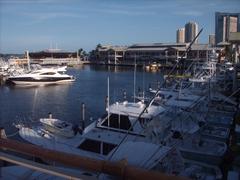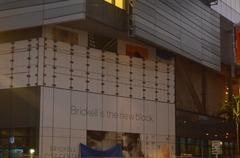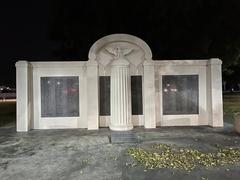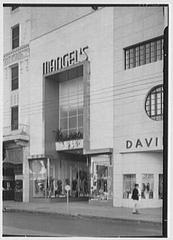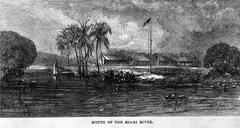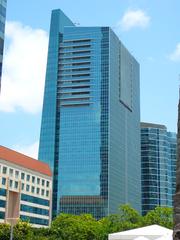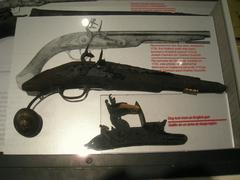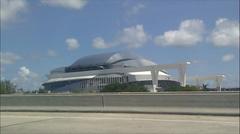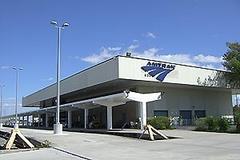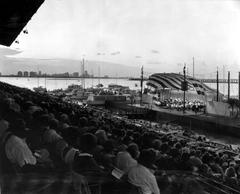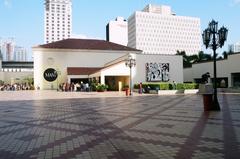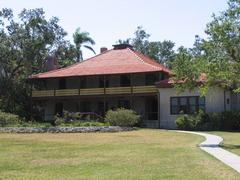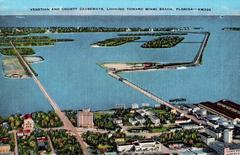
Miami-Dade County Courthouse: Visiting Hours, Tickets, and Historical Significance
Date: 04/07/2025
Introduction
Located in the heart of downtown Miami, the Miami-Dade County Courthouse is not only an architectural icon, but also a symbol of the city’s civic evolution and cultural diversity. Completed in 1928, this Neoclassical landmark at 73 West Flagler Street was once the tallest building in Florida and remains a cornerstone of Miami’s legal, architectural, and social history. Whether you are a history enthusiast, architecture lover, or a curious visitor, the courthouse offers a unique window into Miami’s dynamic past and present (Miami-Dade County Courthouse - Wikipedia; Miami Wonder; Miami History; Miami-Dade County Historic Preservation).
Historical Overview
Early Courthouses and Civic Evolution
Dade County’s judicial roots trace back to the mid-19th century, with the first known courthouse operating out of Dr. Robert Fletcher’s home and trading post near the Miami River around Florida’s statehood in 1845 (Miami History). Through the late 1800s, the county seat shifted locations, reflecting the region’s growth and changing governance structures. By 1899, the courthouse was officially relocated to Miami, establishing it as the permanent seat of county government. Rapid development led to the construction of a limestone courthouse in 1904, but the city’s explosive growth demanded a larger, more modern facility, culminating in the current courthouse’s construction in the 1920s (Wikipedia).
Construction and Architectural Significance
Built between 1925 and 1928 at a cost of $4 million (roughly $54.5 million today), the Miami-Dade County Courthouse is a masterwork of Neoclassical Revival architecture, designed by A. Ten Eyck Brown with associate August Geiger (Miami Wonder). Its 28 stories and 361-foot height made it the tallest building in Florida and the tallest south of Baltimore upon completion. The building’s symmetrical limestone façade, grand columns, and copper-clad dome evoke the dignity and stability of classical democratic institutions (Miami Fitness and Lifestyle). The innovative hexagonal design maximizes its urban footprint and offers stunning views from multiple angles.
Inside, soaring ceilings, marble finishes, ornate plasterwork, and intricate tile mosaics create a sense of grandeur befitting its civic purpose. The courthouse’s robust foundation—concrete pilings driven into bedrock—was an engineering feat, enabling the skyscraper to withstand Miami’s challenging climate, hurricanes, and soft soil (Miami-Dade County Historic Preservation).
Unique Features and Notable Events
The courthouse originally housed not only government offices and courtrooms but also the county jail, occupying its top nine floors. This unusual arrangement led to more than 70 prisoner escapes, including a famed 1934 breakout from the 21st floor, underscoring the challenges of combining judicial and correctional functions in a high-rise (Wikipedia). The building has played host to significant trials and civil rights milestones, including one of the nation’s first Woolworth’s lunch counter sit-ins in 1960 (Women’s History Coalition Miami-Dade).
Civic and Cultural Importance
Symbolism and Community Identity
Beyond its role as a center of justice, the courthouse is a symbol of Miami’s aspirations and multicultural heritage. Its location anchors downtown’s government and legal district, while its design reflects both classical European influences and adaptations for the tropical climate—such as deep-set windows and thick masonry walls (Miami Wonder). The courthouse’s image frequently appears in local iconography, and its status as a gathering place for public ceremonies, naturalization events, and civic protests makes it a living monument to the city’s evolving identity (brandoncollura.com; lonelyplanet.com).
Legal Landmarks
Courtroom 6-1 is particularly notable for hosting historic trials, including proceedings involving national figures like Al Capone, and for its elegant woodwork and classical detailing (miamidade.gov). The courthouse’s legal milestones reflect Miami’s diverse and sometimes turbulent history, reinforcing its reputation as a guardian of justice and a stage for the city’s most significant moments.
Preservation and Recent Developments
Landmark Status and Restoration
The Miami-Dade County Courthouse was added to the U.S. National Register of Historic Places on January 4, 1989, cementing its place among the city’s most important historic sites (baillylectures.com). Restoration efforts have focused on preserving its terra cotta façade, grand lobby, and original courtroom features. Despite these efforts, structural concerns led to the courthouse’s closure in July 2021, accelerating the construction of a new, state-of-the-art justice center nearby (Wikipedia; Plenary).
Future Prospects
Plans for the historic courthouse’s future emphasize adaptive reuse. Russell Galbut’s GFO Investments has proposed acquiring and renovating the landmark, with designs for a 65-story mixed-use tower adjacent to the courthouse. These plans prioritize preserving the building’s historic character while integrating modern amenities, pending approval by preservation and zoning boards (Dade.News; miamitodaynews.com).
Visiting the Miami-Dade County Courthouse
Location and Getting There
- Address: 73 West Flagler Street, Miami, FL 33130 (Miami-Dade County Planning)
- Public Transit: Easily accessible via Metrorail, Metromover (Government Center station), and Metrobus.
- Parking: Multiple public garages and lots nearby; arrive early during peak hours (K Myers Blog).
Visiting Hours and Entry
- Hours: Monday–Friday, 8:00 AM to 5:00 PM (excluding public holidays). Always verify current hours on the official website.
- Entry: Free general admission; no tickets required for standard visits or to observe public proceedings.
- Security: Airport-style screening at entrances. Leave prohibited items at home (K Myers Blog).
Guided Tours and Educational Visits
- Courthouse Visit Program: Tailored tours for school groups (grades 3–12), college students, adults, and international visitors. Includes presentations, mock trials, and courtroom observation (Eleventh Judicial Circuit).
- Booking: Schedule in advance via the official website.
- Special Events: Periodically hosts civic ceremonies and educational programs.
Accessibility and Amenities
- ADA Compliance: Accessible entrances, elevators, and restrooms.
- Amenities: No public cafeteria, but downtown Miami offers plentiful dining options.
Dress Code and Conduct
- Attire: Business casual required for courtroom access (button-up shirts, slacks, closed-toe shoes). Avoid shorts, casual, or revealing clothing (K Myers Blog).
- Decorum: Maintain silence in courtrooms and follow all posted rules.
Photography
- Permitted: In public areas such as the lobby and exterior.
- Restricted: Inside courtrooms and during proceedings; always ask staff for guidance.
Safety Tips
- Urban Awareness: Stay alert in downtown Miami, especially after hours. Use public transportation or well-traveled routes (Travellers Worldwide).
- Belongings: Bring only essentials and avoid carrying valuables.
Nearby Attractions
- HistoryMiami Museum: 0.04 miles away, featuring exhibits on the region’s past.
- Miami-Dade Public Library: 0.1 miles away, with cultural programming and resources.
- Freedom Tower, Bayfront Park, Bayside Marketplace: All within walking distance, offering additional historical and cultural experiences (lonelyplanet.com; Timeout Miami).
Frequently Asked Questions (FAQ)
Do I need tickets to visit?
No, general entry is free. Guided tours require advance scheduling but no ticket purchase.
What are the visiting hours?
Monday–Friday, 8:00 AM to 5:00 PM (excluding holidays). Always check the official website for updates.
Are guided tours available?
Yes, through the Courthouse Visit Program. Schedule in advance on the official site.
Is the courthouse accessible?
Yes, fully ADA-compliant with ramps, elevators, and accessible restrooms.
Can I take photographs?
Yes, in public areas. Photography is restricted in courtrooms and during hearings.
What else is nearby?
Nearby attractions include HistoryMiami Museum, Miami-Dade Public Library, Freedom Tower, Bayfront Park, and Bayside Marketplace.
Visuals and Resources
- Photos: Capture the limestone façade, copper dome, lobby, and architectural details. Use alt tags like “Miami-Dade County Courthouse historical building.”
- Maps: Interactive maps and virtual tours are available via the official courthouse website.
- Internal Links:
Practical Tips for Your Visit
- Schedule guided tours in advance.
- Allow extra time for parking and security.
- Dress appropriately for courtroom observation.
- Bring only essentials; leave prohibited items at home.
- Respect courthouse rules and decorum.
- Explore nearby Miami historical sites to enrich your experience.
Conclusion
The Miami-Dade County Courthouse stands as a testament to Miami’s history, resilience, and civic pride. Its Neoclassical grandeur, storied legal past, and ongoing role in the community make it a must-see for anyone interested in Miami’s heritage. Plan your visit around public hours and guided tours, and enjoy the courthouse in the context of Miami’s vibrant downtown and nearby attractions. For additional resources, updates, and audio tours, download the Audiala app and follow us on social media.
References
- Miami-Dade County Courthouse - Wikipedia
- Miami Wonder
- Miami History
- Miami-Dade County Historic Preservation
- Miami Fitness and Lifestyle
- Plenary
- Dade.News
- Women’s History Coalition Miami-Dade
- Bailly Lectures
- Lonely Planet
- Miami-Dade County Planning
- Eleventh Judicial Circuit
- K Myers Blog
- Travellers Worldwide
- Timeout Miami
- Miami-Dade County Official Site
- Audiala App







